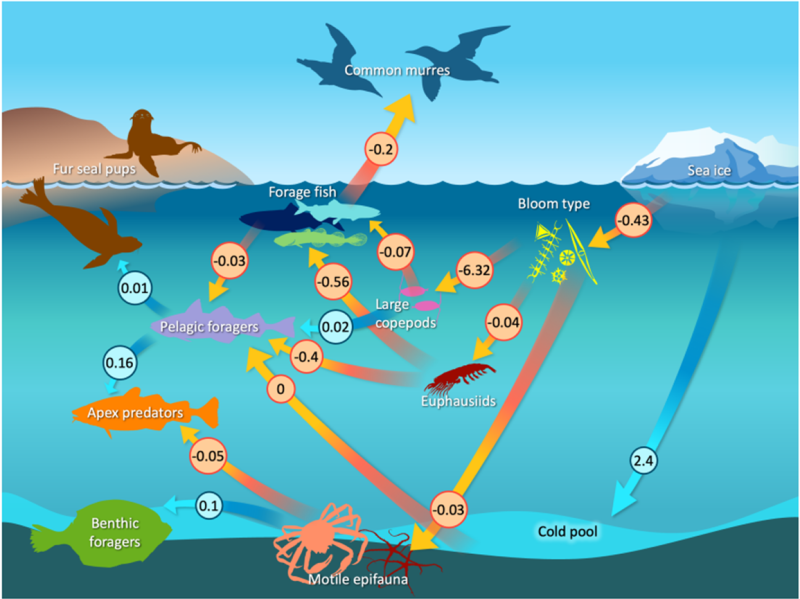Scientists developed a novel approach that combines information from different types of ecosystem models to help account for data gaps and improve understanding of predator-prey relationships in a changing environment.
“What’s particularly exciting about this new approach is that it provides us with a valuable tool to gather and integrate insights from stakeholders into statistical models,” said Jim Thorson, senior scientist, Alaska Fisheries Science Center. “We can now hypothesize ecosystem linkages, quickly test them with data, and learn more about effects that are simultaneous and lagged responses, or responses that happen over time or are delayed.”
Thorson and his colleagues applied the new modeling approach to a couple of case studies. One explored how changing sea ice affects the type of prey Alaska pollock eat during their first year of life and, ultimately, their survival.
In particular, they found during the years 1963–2023 that as sea ice has declined in the eastern Bering Sea, cold water habitats have also decreased. As a result, fewer copepods—microscopic animal life—were available in the fall for young pollock to eat. This, in turn, inhibited early-life survival for Alaska pollock during warm years within this timeframe. This has implications for commercial fisheries because the first year of life is a critical time for young fish. It is when fish mortality is high. If fewer fish survive to maturity, there will be fewer fish available for fishermen to catch. However, krill abundance is less tied to sea ice and provides a critical support for juvenile diet in some warm periods but not others.
Advancing Ecological Modeling Capabilities
Ecological systems typically involve many interacting variables. Ecological dynamics often arise from a combination of simultaneous and lagged effects among these variables. For example, in marine ecosystems, juvenile predators often compete with the same prey that they later consume as adults. As a result, an increase in prey density can have a positive simultaneous effect (due to increased forage for adults) and a negative lagged effect (due to increasing juvenile competition and decreased juvenile survival) on predators.
Scientists typically seek to understand how these variables will change given a policy or experiment. Another way to understand these relationships is by predicting how variables may respond under different climate scenarios based on projections of different levels of greenhouse gas emissions.
These predictions require understanding how a change in one variable will cause a subsequent change in another (termed “causal analysis”). Causal analysis has motivated development of a tremendous range of analytical techniques for predicting and studying changing relationships.
In this approach, Thorson and his team also use causal analysis.
“What’s different here is that it isn’t just a couple of modelers writing code to understand ecological relationships. Stakeholders are the ones informing the models based on their knowledge and understanding of how the ecosystem works,” said Thorson.
To collect this input from stakeholders about natural systems, the scientific team used causal maps. These maps contain boxes to represent variables and arrows to represent interactions. These knowledge about system linkages can then be incorporated into the models, and it complements the data that are typically provided by scientific activities.
Importantly, these models can be fitted rapidly by a wide range of knowledge holders (not just ecosystem modelers). It allows new opportunities to hold workshops and solicit input that is then tested with data and used to forecast ecosystem change.
“We are really excited about the potential for this modeling approach,” stressed Thorson. “It provides a promising tool for integrating local, traditional, and Indigenous knowledge when developing ecological models that can be used for real-world management.”
For instance, one possible application would be to incorporate economic and social indicators and see how the cold pool affects pollock availability to shore-based and offshore catcher-processor vessels.
The approach shows promise for helping fisheries managers and coastal communities better understand the direct and indirect impacts of climate change on important commercial fisheries such as Alaska pollock and subsistence and commercial salmon fisheries. Thorson and his co-authors hope to work with scientists and stakeholders in other regions to further explore the idea.




